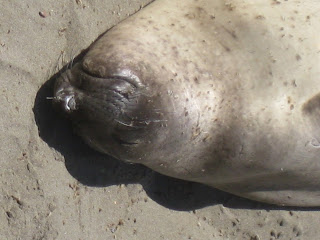

According to Friends of the Elephant Seals, The Northern Elephant Seal, Mirounga angustirostris , is an extraordinary marine mammal.  It spends eight to ten months a year in the open ocean, diving 1000 to 5000 feet deep for periods of fifteen minutes to two hours, and migrating thousands of miles, twice a year, to its land based rookery for birthing, breeding, molting and rest. The Piedras Blancas rookery, on Highway 1 seven miles north of San Simeon on the California Central Coast, is home to about 15,000 animals. The area is open for viewing every day of the year. Elephant seals are sexually dimorphic, that is the males are much larger than the females. Females grow to 9-12 feet and weigh between 900-1800 pounds.  Males grow to 14-16 feet long and weigh in at 3000-5000 pounds, or more. Female elephant seals give birth for the first timearound 4 years old, though the range is between 2-6 years of age. Females are considered physically mature at age 6 with a life expectancy of 20 years. Males enter puberty around 4 years of age, at which time the nose starts to grow. The nose is a secondary sexual characteristic, like a man's beard., and can reach the astonishing length of 2 feet. Males reach physical maturity around 9 years old. Prime breeding age is 9-12, and they have a life expectancy of 14 years. |


- April to May- Females and juveniles
- May to June- sub-adult males
- July-August- Adult males- we saw the larger males (2 large males play-fighting)




















0 comments:
Post a Comment